Forgive the pun, but the skeletal system really is the proverbial “backbone” to a healthy functioning body. It is often overlooked in its importance, and neglected from preventative measures to keep it safe. You may hear people worrying about cholesterol or blood pressure, but when was the last time you heard someone fretting about safeguarding their bones against future problems?
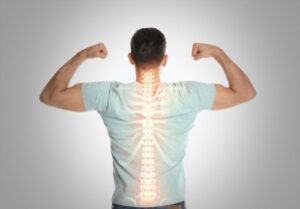
Our skeletal system works together with muscles to allow us to move. Without bones, our body would have no structure, and our vital organs would be unprotected. Not to forget the vital role that bones play in the production of white and red blood cells, and the storage of crucial minerals, in particular calcium.
The adult skeletal system is made up of just over 200 bones which need a constant supply of oxygen, nutrients and blood to retain their health. Bones are lightweight but extremely tough. 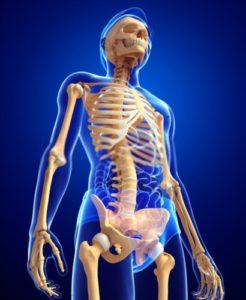
Contrary to common belief, they are a living growing tissue, made mostly from a collagen framework, covered in a protective armour of calcium phosphate. It is the collaboration of collagen and calcium which gives bones their strength and flexibility. Pound for pound, bone is actually stronger than steel.
Our bones are constantly being remodeled in a two part process. Firstly, resorption takes place when osteoclasts (specialized, multinucleated cells) break down and remove bone, followed by formation when osteoblasts and osteocytes form new bone tissue. This cycle of breaking down and rebuilding bone changes over our lifetime, with the bone building being at its fastest during the two major growth periods – in the first three years of life, and during adolescence, thus allowing reshaping during growth, regulating calcium levels, and fixing damaged sections.
Approximately 10% of the skeletal system is renewed each year. During our early twenties the bone density is at its optimum. It is at this stage that preparations should have started to keep our bones in tip-top condition, as after this the bone density starts to breakdown as we age, and by the age of approximately 30 the formation of bone is not quite keeping pace with resorption. If this process is completely out of sync osteopenia may develop, where the inside of the bones become brittle from a loss of calcium, which can progress to osteoporosis.
The World Health Organization (WHO) defines osteoporosis as a bone mineral density that is 2.5 standard deviations or more below average, and have declared osteoporosis as “second most healthcare problem worldwide after cardiovascular disease.”
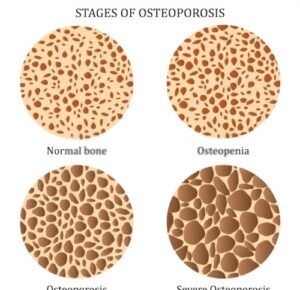 Osteoporosis is known as the “silent disease” since people are unaware that they have it until they break a bone during a fall or sudden impact, since the bones have become more brittle over time. The most common breaks occur in the hip, wrist or spine. Osteoporosis can have a debilitating effect on the health and lifestyle, causing constant pain and limiting movement. In the worst case scenario, it can become serious enough that just constant sitting in one position for a prolonged amount of time can cause a compression fracture. Height can be impacted if the vertebrae are affected and the person becomes hunched.
Osteoporosis is known as the “silent disease” since people are unaware that they have it until they break a bone during a fall or sudden impact, since the bones have become more brittle over time. The most common breaks occur in the hip, wrist or spine. Osteoporosis can have a debilitating effect on the health and lifestyle, causing constant pain and limiting movement. In the worst case scenario, it can become serious enough that just constant sitting in one position for a prolonged amount of time can cause a compression fracture. Height can be impacted if the vertebrae are affected and the person becomes hunched.
Several aspects can influence the development of osteoporosis, including gender, age, family history and ethnicity. Women are at higher risk, especially after menopause when estrogen levels diminish. Men with low testosterone may also be at a higher risk, plus those with an imbalance of thyroid hormones, and those who are underweight (particularly postmenopausal women). It is estimated that over the age of 50, 1 in 3 women and 1 in 5 men will suffer a fracture due to osteoporosis.
Factors and diseases that can influence the body’s ability to utilise calcium properly, thus increasing the risk of osteoporosis in later life, include some digestive conditions and eating disorders, plus the prolonged use of some medications including several anti-seizure medications, corticosteroids, and acid suppressors.
What is worrying is that scientists are Increasingly finding a problem with weak bones in teenagers and even younger children, due to an inadequate diet and possible lack of exercise. Did you know that if the calcium intake isn’t sufficient for keeping the nerves, blood, and muscles healthy, then the body will take the calcium from the bones instead, thus weakening them? The Institute of Medicine recommends that children between the ages of 9 – 18 have a minimum of 1300 mg of calcium every day. To put this in context, one litre of milk provides approximately 1200 mg of calcium.
Making an investment in building bone health and banking extra calcium during youth is making an investment in your future – your health, longevity, mobility, and quality of life. But is it too late now? The lost bone density will not be restored with tissue of equal strength, however you can help to stop a further decline, and build on what you have.
 Studies have indicated that it is possible to increase bone mass and strengthen bones with regular weight bearing exercise including walking, climbing stairs, jogging, cycling, dancing, and anything else that forces the body to work against gravity, plus resistance exercises such as lifting weights. Just a minimum of 20 minutes, three to five days a week, could have a major impact.
Studies have indicated that it is possible to increase bone mass and strengthen bones with regular weight bearing exercise including walking, climbing stairs, jogging, cycling, dancing, and anything else that forces the body to work against gravity, plus resistance exercises such as lifting weights. Just a minimum of 20 minutes, three to five days a week, could have a major impact.
Diet plays an important role, as there are key nutrients needed to enhance bone health: calcium, the essential building block for bone; vitamin D, enhances the absorption of calcium, and aids in growth and remodeling of the bones; magnesium, regulates calcium and vitamin D levels – approximately 60% of magnesium intake is stored in the skeletal system; vitamin K, a coenzyme for proteins required in bone metabolism, helps transport calcium.
Other helpful nutrients include: phosphorus, part of the bone mineral, and helps to neutralize acidic foods which could be harmful to the bones; vitamin A, influences osteoblasts and osteoclasts; zinc, mineralizes the bone; vitamin B12, influences bone-building cells; vitamin C, helps in absorption of iron, essential for collagen formation and a powerful antioxidant; copper, helps form red blood cells together with iron, and helps with iron absorption, a copper deficiency can cause brittle bones; vitamins B6 and B9, help strengthen the bones.
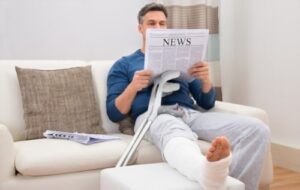 Natural cold pressed oils may be the solution that you are looking for to build a foundation for solid bones in the future, to play catch-up in helping to maintain bone health, to help lessen the effect of already brittle bones in your twilight years, and to speed the healing of fractures due to accident or injury. Take a look at the best 5 oils for bone health:
Natural cold pressed oils may be the solution that you are looking for to build a foundation for solid bones in the future, to play catch-up in helping to maintain bone health, to help lessen the effect of already brittle bones in your twilight years, and to speed the healing of fractures due to accident or injury. Take a look at the best 5 oils for bone health:
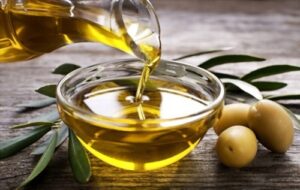 Olive Oil
Olive Oil
Contains: vitamins B1, B2, B6, P, PP, C, E, K, F, plus cobalt, copper, calcium, potassium, magnesium, iron, omega-6, omega-9.
olive oil is richer in antioxidants than any other oil which is believed to play a part in it’s bone protective effects, suppressing inflammation and oxidative stress, influencing the osteoblast’s physiology and thereby increasing bone formation and inhibiting resorption. It is noticeable in Mediterranean countries with a high intake of olive oil in their diet that incidence of osteoporosis is much lower compared with the rest of Europe. Experiments on human bone marrow cells have upheld the belief that olive oil can prevent bone loss due to ageing. An article which was based on the review of 37 scientific studies reported that olive oil may prevent loss of bone mass, therefore protecting against the onset of osteoporosis. Studies on olive oil and its benefits for bone health include: A 2013 study incorporating 188,795 subjects from 8 European countries supported that those with a strict adherence to the Mediterranean diet (high in vegetables, fruits, legumes, nuts, beans, cereals, grains, fish, and olive oil, and generally low on meat and dairy products) had a lower risk of suffering a hip fracture; 127 men aged 55-80 were split in three groups and followed three different diets for two years – one on a Mediterranean diet with higher consumption of nuts, another on Mediterranean diet with virgin olive oil and the third on a regular low-fat diet – researchers found only the diet incorporating olive oil showed higher increases in levels of osteocalcin (a bone hormone) and other bone health markers, and led to them to conclude that olive oil can reduce the risk of a fracture by 51%; a Spanish study highlighted that women consuming olive oil regularly has increased bone mineral density. Add some olive oil to your diet today and protect against broken bones today, and bone disease in the future.
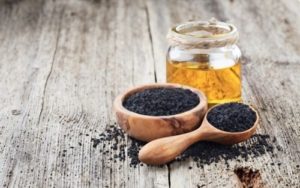 Black Seed Oil
Black Seed Oil
Contains: vitamins C, B1, B2, B6, folic acid, biotin, beta-carotene, plus magnesium, selenium, iron, calcium, sodium, zinc, omega-6, omega-9
Black seed oil is a powerhouse of essential nutrients for bone health. Since 1959 there have been over 150 studies conducted on black seed and thymoquinone (its most abundant volatile oil) regarding the impact on bone health where it has been concluded to be a safe agent to naturally strengthen the bones and potentially protect against and manage osteoporosis. For instance, in animal studies, black seed and/or thymoquinone have been shown to benefit postmenopausal osteoporosis using the ovariectomized rat models, and reverse diabetes-induced bone changes. More recent studies have affirmed the influence of thymoquinone in enhancing bone fracture healing, accelerating bone formation and calcification, including topical use of massaging black seed over the damaged bone.
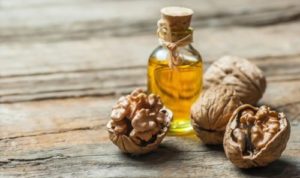 Walnut Oil
Walnut Oil
Contains: vitamins A, E, D, K, C, P, PP, group B vitamins, plus zinc, potassium, manganese, magnesium, iodine, phosphorus, selenium, copper, coenzyme Q 10, omega-3, omega-6, omega-9
Walnuts are an excellent source of copper, in addition to other vital nutrients to protect and strengthen the bones. Copper plays a vital role in the maintenance and formation of collagen, a key building block of bone. It improves bone density, and a severe copper deficiency is known to lower density of the bones which could lead to osteoporosis. Manganese and magnesium also help to improve bone quality – with manganese, in combination with calcium and copper, being shown to protect against osteoporosis, and magnesium contributing to the absorption of calcium into the bone. A 2007 study regarding the impact of omega-3 in walnuts on bone health, published in Nutrition Journal, demonstrated that the participants had less bone loss than those who were given non-omega-3 sources of fat instead. The combined forces of vitamin C and copper are essential for the repair of bones following a fracture, since they both influence collagen which forms the connective tissues to bind the bone back together and repair the damage.
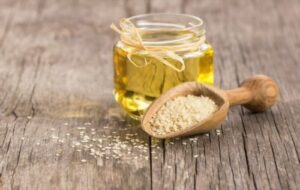 Sesame Oil
Sesame Oil
Contains: vitamins A, B, C, E, K, calcium, copper, iron, magnesium, zinc, omega 3 fatty acids, unsaturated, polyunsaturated and saturated fatty acids.
Sesame is an Ayurveda, the traditional Indian system of medicine, remedy to strengthen the bones and protect against weak bones and osteoporosis. Sesame oil is extremely high in calcium, the foundation for strong bones, and just one teaspoon provides the daily recommended requirement. The high content of copper, magnesium and omega-3 makes sesame oil viable for all bone issues, and regular intake helps to retain bone structure. This oil is also extremely high in zinc, of which low levels have been linked to osteoporosis. Regular massaging with sesame oil can help to slow the bone thinning process. Sesame oil is also found to speed up the recovery of a fracture, accelerating healing and regrowth, and can also reduce inflammation and pain when gently massaged into the area above the fracture.
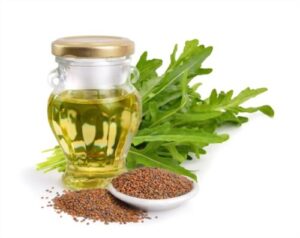 Rucola Seed Oil
Rucola Seed Oil
Contains: Vitamins A, B, C, E and K, plus calcium, iron, zinc, copper, potassium, phosphorus, magnesium, manganese, folate, beta-carotene
Being rich in calcium and vitamin K, rucola seed oil helps to support healthy bones. Whilst calcium may be the building block for the bones, vitamin K is the glue that holds it all together, and experts now believe that vitamin K may contribute more to the construction of strong healthy bones than calcium. Research has shown that vitamin K helps to reduce bone density loss and deterioration, and studies confirm that people taking a higher amount of vitamin K have a reduced risk of bone fractures and developing osteoporosis. Regular intake of rucola seed oil can benefit those already suffering from osteoporosis and therefore is highly recommended for them, in addition to those recovering from broken bones.
Which oil will you choose to protect your bones today, tomorrow and in your twilight years? And remember, it’s never too soon for kids to be building better bones to safeguard their future. Make an investment in bone health today.


